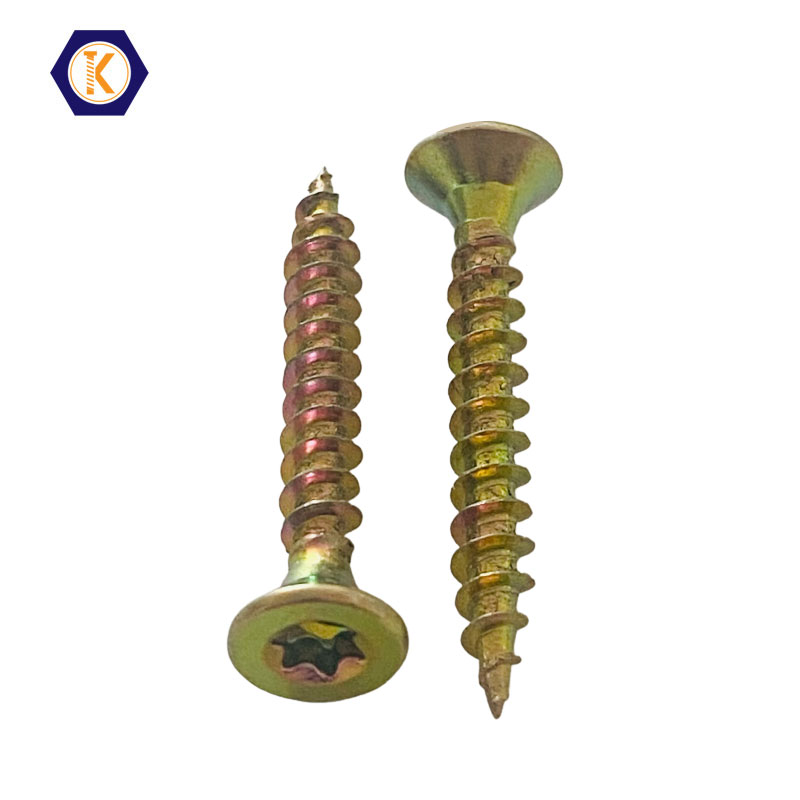Understanding Chipboard Screws: The Essential Tool for Woodworking and Construction
2025-04-08
When it comes to woodworking, furniture assembly, or general construction, the right fasteners are key to achieving durable, long-lasting results. One such fastener that plays a crucial role in these tasks is the chipboard screw. Though it may seem like just another type of screw, chipboard screws are designed specifically to provide superior holding power when working with chipboard, MDF (Medium-Density Fibreboard), plywood, and other engineered wood materials. In this blog, we will explore what chipboard screws are, their unique features, and why they are essential for various DIY and professional projects.
What Are Chipboard Screws?
Chipboard screws are a specialized type of screw designed primarily for use with particleboard, MDF, and other wood-based materials, including chipboard. Unlike standard wood screws, which are often used for solid wood, chipboard screws have specific characteristics that allow them to perform better with engineered woods. These screws are designed to provide a secure grip without causing the material to split, offering superior holding power and durability.
Typically, chipboard screws are made from steel or a similar durable material to withstand the stresses of driving into dense materials. They come in a range of sizes, lengths, and coatings to suit various applications, whether in furniture construction, cabinetry, or general woodworking projects.
Key Features of Chipboard Screws
1. Coarse Thread: One of the most distinguishing features of chipboard screws is their coarse thread. The larger thread pitch allows these screws to grip better into the soft, dense structure of particleboard or MDF, which helps to prevent the screw from pulling out over time.
2. Sharp Point: Chipboard screws are often equipped with a sharp point that makes them easier to drive into the material. This helps prevent splitting, a common problem when working with engineered woods. The sharp point also reduces the need for pre-drilling, which saves time and effort during the installation process.
3. Large Head: The larger head of a chipboard screw helps distribute pressure over a larger surface area, reducing the risk of damaging the material while still ensuring a strong, secure fit. This feature is particularly important when attaching components to chipboard or MDF, which can be more fragile than solid wood.
4. Corrosion Resistance: Chipboard screws are often coated with materials like zinc, galvanized plating, or other corrosion-resistant finishes to protect them from rust and wear. This is especially important for projects that will be exposed to moisture or environmental elements, such as outdoor furniture or cabinetry in damp areas.
Why Are Chipboard Screws Important?
Chipboard screws are essential for anyone working with engineered woods like chipboard, MDF, or plywood. Here’s why:
1. Superior Holding Power: Because engineered woods are made up of compressed wood fibers, they can sometimes be weaker than solid wood. Chipboard screws provide a strong hold, ensuring that your connections remain intact even under stress or pressure. This makes them ideal for furniture construction, shelving, or other structures that require a durable, long-lasting bond.
2. Prevention of Splitting: One of the most significant challenges when working with MDF, particleboard, and chipboard is the risk of the material splitting when screws are driven in. The coarse threads and sharp points of chipboard screws help minimize this risk, allowing for a clean and secure installation.
3. Time and Effort Savings: Thanks to their ability to drive into materials without pre-drilling, chipboard screws save time during assembly. This feature is particularly beneficial when working with large quantities of materials, such as in mass furniture production or DIY projects.
4. Cost-Effective: Chipboard screws are typically affordable and cost-effective, making them a great choice for both professional contractors and DIY enthusiasts. They offer excellent value for money, especially when used in large-scale projects where numerous screws are needed.
Applications of Chipboard Screws
Chipboard screws are commonly used in a variety of applications, particularly in the construction and furniture industries. Some of the most common uses include:
1. Furniture Assembly: Chipboard screws are often used to assemble flat-pack furniture, such as bookshelves, cabinets, and desks. Their ability to secure components without damaging the material makes them perfect for these types of projects.
2. Cabinetry: In cabinetry, chipboard screws are used to attach various panels, doors, and other components. Their strong hold is essential for maintaining the structural integrity of cabinets, particularly in kitchens and bathrooms where the materials may be subject to moisture.
3. Building and Construction: Chipboard screws are used to fasten plywood and chipboard in construction projects. They are commonly used for flooring, wall panels, and other structural elements where engineered wood materials are employed.
4. DIY Projects: Whether you're building your own furniture, creating shelves, or constructing decorative pieces, chipboard screws are an excellent choice for DIYers. They provide the necessary strength without requiring advanced tools or expertise.
How to Choose the Right Chipboard Screw
When selecting chipboard screws for your project, there are several factors to consider:
1. Size and Length: Choose the appropriate size based on the thickness of the material you're working with. A screw that is too short may not provide enough hold, while one that is too long could go through the material, causing damage.
2. Coating: If your project will be exposed to moisture or outdoor elements, consider using chipboard screws with a corrosion-resistant coating, such as zinc or galvanized plating.
3. Head Type: Chipboard screws come with different types of heads, including flat, pan, or countersunk. Choose the head type that best suits your project’s requirements, such as one that will sit flush with the surface or one that is more prominent.
4. Drive Type: Chipboard screws come with various drive types, including Phillips, slotted, and Pozidriv. Select the drive type that works best with your tools and offers the best grip for driving the screw.
Conclusion
Chipboard screws are a vital tool for any woodworking or construction project that involves engineered woods like MDF, plywood, and particleboard. They offer superior holding power, help prevent material splitting, and save time during assembly. Whether you're building furniture, assembling cabinets, or tackling DIY projects, these screws are essential for ensuring a secure and durable outcome.
When choosing chipboard screws, consider factors such as size, coating, and head type to ensure they are the right fit for your specific project. With the right screw, you can ensure that your work will stand the test of time and deliver the results you're looking for.



